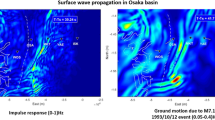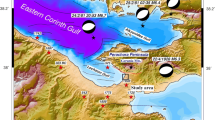Abstract
Subsurface velocity structures must be estimated to predict long-period ground motions and seismic hazards. Subsurface velocity structures can be constructed via an inversion of the horizontal-to-vertical (H/V) spectral ratio of microtremor (MHV) curves; thus, a method of simulating the MHV curves is key. In this study, we use the H/V spectral ratio of the surface wave (SHV) based on the surface wave propagation theory in a layered half-space to simulate the MHV curves at sites A and B of the Yuxi basin. Then, we attempt to analyze the features of the SHV curves. We find the H/V ratio of the microtremor loading source to be independent of the peak frequency of the SHV curve, but it has some relation to the amplitude of the SHV curve. Moreover, to reduce the error in subsurface velocity structures obtained by the MHV curves, we suggest that the SHV curves at near-peak frequencies should not be considered in the inversion, because the amplitude deviation is higher at the peak frequency of the MHV curve. In addition, the best frequency ranges for the inversion of the microtremor H/V spectrum are between the peak and trough frequencies of the microtremor H/V spectrum.








Similar content being viewed by others
References
Aki K (1957) Space and time spectra of stationary stochastic waves, with special reference to microtremors. Bull Earthq Res Inst Tokyo Univ 35:415–456
Apostolidis P, Raptakis D, Roumelioti Z, Pitilakis K (2004) Determination of S-wave velocity structure using microtremors and SPAC method applied in Thessaloniki (Greece). Soil Dyn Earthq Eng 24(1):49–67. https://doi.org/10.1016/j.soildyn.2003.09.001
Arai H, Tokimatsu K (2000) Effects of Rayleigh and Love waves on microtremor H/V spectra. In: the 12th world conference on earthquake engineering, Auckland, New Zealand, 30 January–4 February 2000
Arai H, Tokimatsu K (2004) S-wave velocity profiling by inversion of microtremor H/V spectrum. Bull Seismol Soc Am 94(1):53–63
Arai H, Tokimatsu K (2005) S-wave velocity profiling by joint inversion of microtremor dispersion curve and horizontal-to-vertical (H/V) spectrum. Bull Seismol Soc Am 95(5):1766–1778. https://doi.org/10.1785/0120040243
Bonnefoy-Claudet S, Cornou C, Bard PY, Cotton F, Moczo P, Kristek J, Fäh D (2006) H/V ratio: a tool for site effects evaluation. Results from 1-D noise simulations. Geophys J Int 167(2):827–837
Bonnefoy-Claudet S, Köhler A, Cornou C, Wathelet M, Bard PY (2008) Effects of Love waves on microtremor H/V ratio. Bull Seismol Soc Am 98(1):288–300
Capon J (1969) High-resolution frequency-wavenumber spectrum analysis. Proc IEEE 57(8):1408–1418
Carcione JM, Picotti S, Francese R, Giorgi M, Pettenati F (2017) Effect of soil and bedrock anelasticity on the S-wave amplification function. Geophys J Int 208:424–431
Chen XL, Gao MT, Yu YX, Chen K, Li TF (2014) Applicability of topographic slope method for seismic site soil classification of Yuxi-Jiangchuan-Tonghai-Basin in China. Earthq Eng Eng Dyn S1:146–152 (in Chinese)
Claprood M, Asten MW, Kristek J (2011) Using the SPAC microtremor method to identify 2D effects and evaluate 1D shear-wave velocity profile in valleys. Bull Seismol Soc Am 101(101):826–847. https://doi.org/10.1785/0120090232
Delgado J, Casado CL, Giner J, Estevez A, Cuenca A, Molina S (2000) Microtremors as a geophysical exploration tool: applications and limitations. Pure Appl Geophys 157(9):1445–1462
Dolenc D (2005) Microseisms observations in the Santa Clara Valley, California. Bull Seismol Soc Am 95(3):1137–1149
Endrun B (2011) Love wave contribution to the ambient vibration H/V amplitude peak observed with array measurements. J Seismol 15(3):443–472
Fäh D, Kind F, Giardini D (2001) A theoretical investigation of average H/V ratios. Geophys J Int 145(2):535–549
Fäh D, Kind F, Giardini D (2003) Inversion of local s-wave velocity structures from average H/V ratios, and their use for the estimation of site-effects. J Seismol 7(4):449–467. https://doi.org/10.1023/B:JOSE.0000005712.86058.42
Gao MT, Yu YX, Zhang XM, Wu J, Hu P, Ding YH (2002) Three-dimensional finite-difference simulations of ground motions in the Beijing area. Earthq Res China 18(4):356–364 (in Chinese)
García-Jerez A, Luzón F, Sánchez-Sesma FJ, Lunedei E, Albarello D, Santoyo MA, Almendros J (2013) Diffuse elastic wavefield within a simple crustal model. Some consequences for low and high frequencies. J Geophys Res-Solid Earth 118(10):5577–5595
García-Jerez A, Piña-Flores J, Sánchez-Sesma FJ, Luzón F, Perton M (2016) A computer code for forward calculation and inversion of the H/V spectral ratio under the diffuse field assumption. Comput Geosci 97:67–78
Guéguen P, Cornou C, Garambois S, Banton J (2007) On the limitation of the h/v spectral ratio using seismic noise as an exploration tool: application to the grenoble valley (france), a small apex ratio basin. Pure Appl Geophys 164(1):115–134. https://doi.org/10.1007/s00024-006-0151-x
Harkrider DG (1964) Surface waves in multilayered elastic media, part 1. Bull Seismol Soc Am 54(2):627–679
Harkrider DG (1970) Surface waves in multilayered elastic media, part 2. Bull Seismol Soc Am 60(6):1937–1987
Haskell NA (1953) The dispersion of surface waves on multilayered media. Bull Seismol Soc Am 43(1):17–34
He ZQ, An HS, Shen K, Lu LY, Hu G, Ye TL (2013) Detection of Puduhe fault in Yuxi basin of Yunnan by seismic reflection method. Acta Seismol Sin 35(6):836–847 (in Chinese)
Hobiger M, Bard PY, Cornou C, Bihan NL (2009) Single station determination of Rayleigh wave ellipticity by using the random decrement technique (RayDec). Geophys Res Lett 36(14):L14303
Horike M (1985) Inversion of phase velocity of long-period microtremors to the S-wave-velocity structure down to the basement in urbanized areas. J Phys Earth 33(2):59–96
Köhler A, Ohrnberger, M., Scherbaum, F (2006) The relative fraction of Rayleigh and Love waves in ambient vibration wavefields at different European sites. In: Third international symposium on the effects of surface geology on seismic motion Grenoble, France, 30 August–1 September 2006
Köhler A, Ohrnberger M, Scherbaum F, Wathelet M, Cornou C (2007) Assessing the reliability of the modified three-component spatial autocorrelation technique. Geophys J Int 168(2):779–796
Komatitsch D, Liu Q, Tromp J, Süss P, Stidham C, Shaw JH (2004) Simulations of ground motion in the Los Angeles basin based upon the spectral-element method. Bull Seismol Soc Am 94(1):187–206
Lachetl C, Bard PY (1994) Numerical and theoretical investigations on the possibilities and limitations of Nakamura’s technique. Earth Planets Space 42(5):377–397. https://doi.org/10.4294/jpe1952.42.377
Lunedei E, Albarello D (2010) Theoretical HVSR curves from full wavefield modelling of ambient vibrations in a weakly dissipative layered Earth. Geophys J Int 181(2):1342–1342
Lunedei E, Malischewsky P (2015) A review and some new issues on the theory of the H/V technique for ambient vibrations. Perspectives on european earthquake engineering and seismology. Springer, New York, pp 371–394
Malischewsky PG, Scherbaum F (2004) Love’s formula and H/V-ratio (ellipticity) of Rayleigh waves. Wave Motion 40:57–67
Nogoshi M, Igarashi T (1971) On the amplitude characteristics of microtremor (part 2). J Seismol Soc Jpn 24(1):26–40
Özalaybey S, Zor E, Ergintav S, Tapırdamaz MC (2011) Investigation of 3-d basin structures in the İzmit bay area (turkey) by single-station microtremor and gravimetric methods. Geophys J Int 186(2):883–894
Parolai S, Picozzi M, Richwalski SM, Milkereit C (2005) Joint inversion of phase velocity dispersion and H/V ratio curves from seismic noise recordings using a genetic algorithm, considering higher modes. Geophys Res Lett 32(1):67–100. https://doi.org/10.1029/2004GL021115
Picozzi M, Parolai S, Richwalski SM (2005) Joint inversion of H/V ratios and dispersion curves from seismic noise: estimating the S-wave velocity of bedrock. Geophys Res Lett 32(11):339–357. https://doi.org/10.1029/2005GL022878
Piña-Flores J, Perton M, Garcíajerez A, Carmona E, Luzon F, Molina-Villegas JC, S´anchez-Sesma FJ (2017) The inversion of spectral ratio H/V in a layered system using the diffuse field assumption. Geophys J Int 208:577–588
Rhie J, Dreger D (2009) A simple method for simulating microseism H/V spectral ratio in 3D structure. Geosci J 13(4):401–406. https://doi.org/10.1007/s12303-009-0036-y
Rong MS, Wang ZM, Woolery EW, Lyu YJ, Li XJ, Li SY (2016) Nonlinear site response from the strong ground-motion recordings in western China. Soil Dyn Earthq Eng 82(4):99–110
Sánchez-Sesma FJ, Rodríguez M, Iturrarán-Viveros U, Luzón F, Campillo M, Margerin L, García-Jerez A, Suarez M, Santoyo MA, Rodríguez-Castellanos A (2011) A theory for microtremor H/V spectral ratio: application for a layered medium. Geophys J Int 186(1):221–225. https://doi.org/10.1111/j.1365-246X.2011.05064.x
Satoh T, Kawase H, Iwata T, Higashi S, Sato T, Irikura K, Huang HC (2001) S-wave velocity structure of the Taichung basin, Taiwan, estimated from array and single-station records of microtremors. Bull Seismol Soc Am 91(5):1267–1282
Seht IV, Wohlenberg J (1999) Microtremor measurements used to map thickness of soft sediments. Bull Seismol Soc Am 89(1):250–259
Shani-Kadmiel S, Tsesarsky M, Louie JN, Gvirtzman Z (2012) Simulation of seismic-wave propagation through geometrically complex basins: the dead sea basin. Bull Seismol Soc Am 102(4):1729–1739
Tamura S (1996) Comparison of body and Rayleigh wave displacements generated by a vertical point force on a layered elastic medium. In the 11th World conference on earthquake engineering, Acapulco, Mexico, 23–28 June 1996
Tsuboi S, Saito M (1983) Partial derivatives of Rayleigh wave particle motion. Earth Planets Space 31(2):103–113
Uebayashi H (2003) Extrapolation of irregular subsurface structures using the horizontal-to-vertical spectral ratio of long-period microtremors. Bull Seismol Soc Am 93(2):570–582
Uebayashi H, Kawabe H, Kamae K (2012) Reproduction of microseism H/V spectral features using a three-dimensional complex topographical model of the sediment-bedrock, interface in the Osaka sedimentary basin. Geophys J Int 189(2):1060–1074. https://doi.org/10.1111/j.1365-246X.2012.05408.x
Wu CF, Huang HC (2012) Estimation of shallow S -wave velocity structure in the Puli basin, Taiwan, using array measurements of microtremors. Earth Planets Space 64(5):389–403. https://doi.org/10.5047/eps.2011.12.002
Yamanaka H, Takemura M, Ishida H, Niwa M (1994) Characteristics of long-period microtremors and their applicability in exploration of deep sedimentary layers. Bull Seismol Soc Am 84(6):1831–1841
Acknowledgements
This research work was supported by the National Natural Science Foundation of China (Nos. 51278470, 51678537) and the Key Laboratory of Seismic Observation and Geophysical Imaging Project. The microtremor records were obtained from the China Seismic Array at http://www.chinaarray.org. The authors thank the anonymous referees for their comments, which contributed to improving the work.
Author information
Authors and Affiliations
Corresponding author
Ethics declarations
Conflict of interest
On behalf of all authors, the corresponding author states that there are no conflicts of interest.
Rights and permissions
About this article
Cite this article
Zhang, Z., Chen, X., Gao, M. et al. Simulation of the microtremor H/V spectrum based on the theory of surface wave propagation in a layered half-space. Acta Geophys. 66, 121–130 (2018). https://doi.org/10.1007/s11600-018-0112-7
Received:
Accepted:
Published:
Issue Date:
DOI: https://doi.org/10.1007/s11600-018-0112-7




